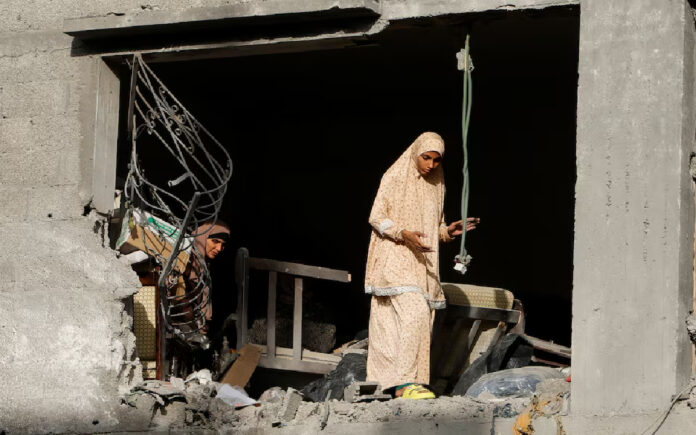Jerusalem: Israel has announced a significant escalation of its military operations in Gaza, declaring plans to seize large sections of the enclave and incorporate them into its security zones. The move, accompanied by mass evacuations, comes as fighting intensifies in the war-torn region.
In a statement, Defence Minister Israel Katz confirmed that evacuations would occur in areas witnessing active combat. He urged the local population to take action against Hamas and facilitate the return of Israeli hostages, calling it “the only way to end the war.”
“The operation aims to dismantle militant strongholds and infrastructure while incorporating vast areas into Israel’s security perimeter,” Katz said.
Israel announced a major expansion of military operations in Gaza, saying swathes of the enclave would be seized and added to its security zones, accompanied by large-scale evacuations of the population https://t.co/ATLnNT2JKM pic.twitter.com/ctDJT8ASC9
— Reuters (@Reuters) April 2, 2025
Civilian Displacement and Heavy Casualties
Israeli forces had already issued evacuation notices to residents in various southern districts of Gaza. Palestinian radio reports indicate that the area surrounding Rafah is now nearly deserted following the orders.
Gaza’s Health Ministry reported that at least 60 people were killed in Israeli airstrikes on Wednesday, including 19 individuals—children among them—who lost their lives in a strike on a United Nations facility sheltering displaced civilians.
The Israeli military stated that the targeted building, previously used as a clinic, was being utilized by Hamas as a command and control center to coordinate attacks. According to the military, surveillance measures were employed to minimize harm to civilians. Hamas has denied these allegations, dismissing them as “blatant fabrications.”
Footage from Reuters captured the aftermath of the attack, showing bloodstained floors and rescue teams carrying bodies on stretchers. In Khan Younis, Rida al-Jabbour held up a small shoe near a blood-spattered wall, recounting the death of a neighbor and her three-month-old child in another strike.
“From the moment the strike happened, we haven’t been able to sit, sleep, or do anything,” she said, describing the difficulty of separating the remains of those killed.
Expansion of the Buffer Zone
While Katz’s statement did not specify the extent of land Israel intends to seize, concerns have risen over whether the move signals a permanent annexation of Palestinian territory. Human rights organization Gisha estimates that Israel has already taken control of approximately 62 square kilometers—roughly 17% of Gaza’s total land area—as part of a buffer zone.
Meanwhile, Israeli leaders have indicated plans to encourage the voluntary departure of Palestinians from the enclave. This follows remarks from former U.S. President Donald Trump, who suggested that Gaza be permanently evacuated and transformed into a coastal resort under U.S. supervision.
Israeli Prime Minister Benjamin Netanyahu reiterated that sustained military pressure was the most effective strategy to secure the release of the remaining 59 hostages.
“It seems like Netanyahu will not stop his war on Gaza until we are displaced. But despite the extermination happening to us and the extreme anguish—as a citizen, I have been displaced eight times—by God’s will, we will remain steadfast,” said Amer al-Farra, a Palestinian resident of Gaza.
Israeli authorities have cited growing dissent within Gaza against Hamas, viewing it as an opportunity to weaken the group’s grip over the enclave. The expanded military operation appears aimed, at least in part, at increasing civilian pressure on Hamas leadership.
“I call on the residents of Gaza to act now to eliminate Hamas and return all the kidnapped,” Katz said. “This is the only way to end the war.”
Regional Tensions and Diplomatic Stalemate
The latest escalation follows a two-month truce, brokered by the United States, which allowed for an exchange of hostages held by Hamas and Palestinian prisoners detained in Israeli jails. However, with negotiations failing to yield further progress, Israel resumed airstrikes last month and deployed ground forces back into Gaza.
Hundreds of Palestinians have been killed since the renewed military offensive began, and Israel has further restricted humanitarian aid to the region, alleging that Hamas has been diverting supplies.
Efforts led by Qatari and Egyptian mediators to revive ceasefire talks have stalled, while growing unrest within Israel has led to protests from the families of hostages demanding government action.
Also Read | Turkey Slams Opposition’s Shopping Boycott as ‘Economic Sabotage’
Beyond Gaza, the conflict has escalated into neighboring regions. Israeli airstrikes have targeted locations in southern Lebanon and Syria. A recent attack on a Hezbollah commander in Beirut’s southern suburbs has further strained an already fragile ceasefire agreement that had largely prevented hostilities since January.
Israel launched its offensive against Gaza following a large-scale attack by Hamas militants on southern Israel, which left 1,200 people dead and 251 taken hostage, according to Israeli tallies.
Since then, Palestinian health officials estimate that Israeli military actions have resulted in over 50,000 Palestinian deaths and widespread destruction. The ongoing conflict has displaced nearly the entire 2.3 million population of the enclave, deepening the humanitarian crisis.



